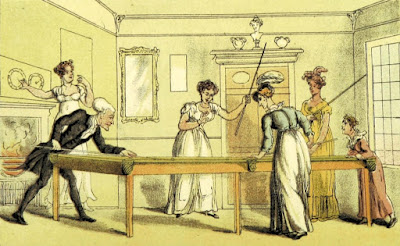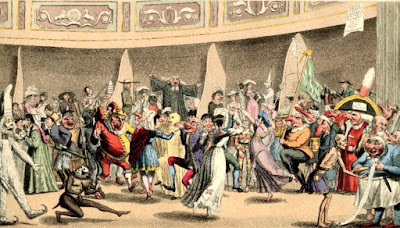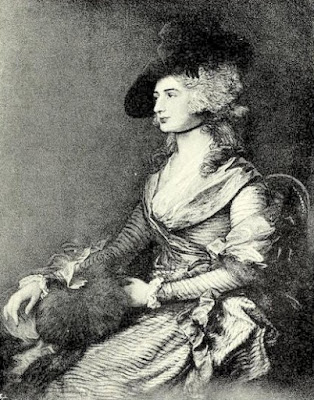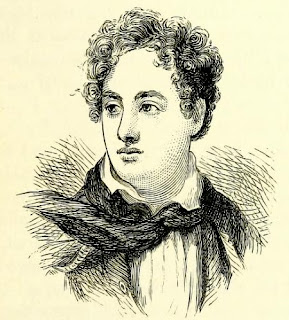 |
| The Cyprian's Ball by R Cruikshank in The English Spy by B Blackmantle (1825) |
The Fashionable Institution
The Argyll Rooms were originally part of the house of John Campbell, 2nd Duke of Argyll. Some of the Duke’s house was demolished to make way for Little Argyll Street and the north wing was later bought by Lieutenant Colonel Henry Francis Greville for the sum of £70.
By means of borrowed money and subscriptions, Greville refurbished and transformed the house and opened it as The Fashionable Institution in 1806.
According to Old and New London:
The establishment was founded under the auspices of Colonel Greville, a noted sportsman and "man about town" under the Regency, who purchased a large house and turned it into a place of entertainment, as a rival to the Pantheon. The fashionable world worshipped at Colonel Greville's shrine, and its balls, masquerades, and amateur balls soon became part of the recognised amusements of West-end society.2
In 1807 and 1808, Greville was granted an annual licence by the Lord Chamberlain for dancing, burlettas and dramatic performances, but from 1809, the licence was limited to music and dancing with occasional permission for masked balls.
By 1811, Greville was in serious financial difficulties and the following year he went abroad. By this time, his associate Stephen Slade, a glass and china dealer, was already running the rooms and Slade became the owner in 1813. Slade ran the Argyll Rooms until 1819 when they were compulsorily purchased due to John Nash’s redevelopment of Regent Street. Slade received £22,750 in compensation.
What were the Argyll Rooms like?
The Picture of London for 1809 described the rooms:
FASHIONABLE INSTITUTION, ARGYLE STREET.
The fanciful elegance with which the internal parts of this building are fitted up, reflects the highest credit on the taste of Colonel Greville, the founder of the institution, from whose design, and under whose direction, the whole has been executed. From the following description, some idea may be formed of the general effect.
The entrance and lobbies are ornamented with Corinthian pillars, and illuminated with gilt lamps. On the ground floor are three spacious supper rooms; the first of which is of a grey colour, hung with scarlet drapery; the paper of the second, is a stone-colour and green trellis, and the drapery is a rich salmon colour, lined with pea-green; the third, though not so superb as the former, is fitted up in a corresponding style, and the whole are brilliantly illuminated, with glass and gilt lamps and chandeliers.
The grand saloon, which is employed both for the purpose of theatrical representation, and as a ball room, is of an oblong form with elliptical terminations. On each side, and over the entrance, are three tiers of boxes, amounting in the whole to about four and twenty. The first range above the ground tier, is ornamented with elegant antique bass reliefs in bronze; the upper tier is of aetherial blue, decorated with scrolls in stone colour, and both are inclosed with rich gold mouldings. Over each box, is a beautiful circular bronze chandelier, with cut glass pendants; the draperies are of scarlet, and the supporters between the boxes represent the Roman ox, and fasces in bronze and gold.
At the opposite end are the orchestra and stage, over which is the following appropriate motto, “Sollicitae jucunda oblivia vitae.” The walls of the middle space, which is of an ample size, are superbly ornamented with ranges of Corinthian pillars, representing porphyry, with capitals of gold. On the intermediate pannels, which are surrounded with borders of blue and gold, are bass reliefs, in stone colour, as large as life, the subjects of which are admirably adapted to the purpose for which they are employed.
On each side of this magnificent room, are tiers of benches, covered with scarlet, over which are suspended eight superb glass chandeliers, and the whole internal space is marked out with chalk, in the most fanciful manner. Contiguous to this are a refectory, painted with landscapes and wreathes of flowers, and a billiard-room, fitted up with singular neatness. On the other side, is a spacious chamber appropriated to cards, the ceiling of which is richly painted, and the windows are hung with scarlet drapery.
Adjoining this is a small apartment, called the blue room, decorated in the most pleasing and elegant style. The drapery is of light blue, and the sophas with which the room is compleatly surrounded, are all of the same colour; the walls are ornamented with much fancy, to harmonize with the furniture, and in the middle of the ceiling, which represents the open sky, is an eagle suspending a chandelier of bronze and gold. In short, the whole building is fitted up in a manner the most superb and tasteful that can be conceived. The first-rate performers, both vocal and instrumental, are engaged, and theatrical representations, concerts, balls, and masquerades, alternately succeed each other in elegant variety. No expence is spared to render this at once the most splendid and commodious place of amusement in the metropolis. It is supported by subscription amongst the principal nobility, for whose use it is exclusively established.3
 |
| The billiard table by T Rowlandson in The Three Tours of Doctor Syntax by W Combe (1868) |
The Argyll Rooms were supported by subscriptions. The Picture of London for 1809 listed the rates as:
Ladies – 10 guineas
Gentlemen – 12 guineas
A lady and her unmarried daughter – 16 guineas
Masquerades
The first entertainment Greville held at the Argyll Rooms was a subscription masked ball on 2 June 1806 which was attended by more than 500 people including the Prince of Wales, the Duke of Cambridge and the Duchess of York. The fancy dress costumes included a mail coach guard, a peasant girl, a sailor, a lame Chelsea pensioner, a Venetian nobleman and Doctor Lancet, who went around feeling the pulse of the ladies.4
Masquerades became a regular feature of the Argyll Rooms. The subscription masquerades were tightly governed, with extra tickets only being offered to those who met with the approval of the lady patronesses, or at the very least, the recommendation of a subscriber who took responsibility for their respectability. This suggests an exclusivity that was akin to that of Almack’s Assembly Rooms.
A masquerade was held on 17 April 1807 and subscribers were requested to apply for their non-transferable masquerade ticket on the morning of the masquerade. An extra 200 tickets, costing two guineas each, were available to non-subscribers, but subject to the approval of the lady patronesses and a committee of subscribers. The transference of a ticket was absolutely forbidden and subscribers were warned that they would forfeit their whole subscription if they broke the rules.5
The subscription masquerade and fancy dress ball held on 9 June 1813 was held under the patronage of the Countess of Jersey, the Countess of Cholmondeley, the Countess Cowper, Viscountess Melbourne, Lady Boringdon, Mrs Thomas Hope and Mrs Boehm. An advertisement in The Times stated that tickets could not be bought unless the purchaser had a voucher from a patroness.6
Other masquerades held at the Argyll Rooms were less exclusive. A ‘benefit masqued ball’ was held by Stephen Slade at the Argyll Rooms on 6 June 1810 and people had to leave their name and address at the office in order ‘to prevent the intrusion of improper persons.’ Gentlemen’s tickets cost £1 11s 6d and ladies’ tickets cost £1 1s. Tickets included refreshments, supper, old port, sherry, Madeira and claret.7
A masquerade held the following year advertised that tickets were available from a masquerade warehouse in the Strand ‘as usual’ along with dominos, masks, hats and fancy dresses for hire.8
 |
| Masquerade, Argyll Rooms Print by T Lane Published by George Hunt (1826) © British Museum |
The Cyprian’s Ball
According to The English Spy, in 1818, a courtesan named Augusta Corri (who called herself Lady Hawke, claiming that one of her lovers, Lord Hawke, had married her) held a grand masked ball or Venetian carnival at the Argyll Rooms:
Robert Cruikshank’s illustration of The Cyprian’s Ball is shown at the top of this page.A few amorous noblemen and wealthy dissolutes, ever on the qui vive for novelty, projected and sanctioned the celebrated Venetian carnival given at the Argyll-rooms under the patronage of her ladyship and four other equally celebrated courtezans. Of course, the female invitations were confined exclusively to the sisterhood … Nor was there any lack of distinguished personages of the other sex; almost all the leading roués of the day being present … the elegance and superior arrangement of this Cytherean fete was in the most exquisite taste; and such was the number of applications for admissions, and the reported splendour of the preparations, that great influence in a certain court was necessary to insure a safe passport into the territories of the Paphian goddess.9
Theatrical performances
On 20 July 1807, Greville opened his ‘New Private Saloon Theatre, Argyle Street’ for the first time, with a benefit performance by Frederick Schirmer’s family company of the German opera The Three Sisters and the English farce, Lovers’ Quarrels. Tickets were priced at half a guinea each and the performance began at 8 o’clock.10
Sarah Siddons at the Argyll Rooms
 |
| Sarah Siddons from The Portfolio, Monographs on Artistic Subjects edited by PG Hamerton (1894) |
Sarah Siddons was the most famous tragic actress of her time. She was widely acclaimed for her roles in Shakespearian plays, particularly as Lady Macbeth. I chose her as one of my twelve women in What Regency Women Did For Us because of her role in helping to make acting a respectable profession for women.
In the seasons following her retirement from the stage in 1812, Sarah Siddons gave some public readings from Shakespeare and Milton at the Argyll Rooms. The size of the venue was ideal for the performances, allowing the audience to see and appreciate all of Sarah Siddons’s wonderful facial expressions and the readings proved very popular.
Concerts
The Argyll Rooms were a popular venue for concerts and lectures.
The celebrated Madame Catalani gave a grand concert at the rooms on Friday 12 June 1807. Tickets were one guinea each.11
On 8 March 1813, the newly formed Philharmonic Society gave its first concert at the Argyll Rooms. They continued to perform at the Argyll Rooms until 1830.
Lord Byron on the Argyll Rooms
 |
| Lord Byron from Literary Celebrities published by W&R Chambers (1887) |
Lord Byron referred to the Argyll Rooms in his satirical poem English Bards and Scotch Reviewers in 1809:
Or, hail at once the patron and the pileOf vice and folly, Greville and Argyle!Where yon proud palace Fashion's hallowed fane,Spreads wide her portals for the motley train,Behold the new Petronius of the day,The Arbiter of pleasure and of play!There the hired Eunuch, the Hesperian choir,The melting lute, the soft lascivious lyre,The song from Italy, the step from France,The midnight orgy, and the mazy dance,The smile of beauty, and the flush of wine,For fops, fools, gamesters, knaves, and Lords combine;Each to his humour, - Comus all allows;Champaign, dice, music, or your neighbour’s spouse.Talk not to us, ye starving sons of trade!Of piteous ruin, which ourselves have made:In Plenty’s sunshine Fortune’s minions bask,Nor think of Poverty, except “en masque,”When for the night some lately titled assAppears the beggar which his grandsire was.The curtain dropped, the gay Burletta o’er,The audience take their turn upon the floor;Now round the room the circling dow’gers sweep.Now in loose waltz the thin-clad daughters leap:The first in lengthen’d line majestic swim,The last display the free, unfettered limb:Those for Hibernia’s lusty sons repairWith art the charms which Nature could not spare:These after husbands wing their eager flight.Nor leave much mystery for the nuptial night.12
The new rooms (1820-1830)
 |
| View of Regent Street showing Argyll Concert Room on the right Print by C Heath after W Westall Published by Hurst, Robinson & Co (1825) © British Museum |
Leigh’s New Picture of London (1827) described the new rooms:
Argyle Rooms, Regent-street.This rendezvous of fashion was, a few years since, a private residence, which was purchased by Colonel Greville, and converted into a place of entertainment, frequented only by the upper classes of society. In 1818, the Royal Harmonic Institution took down the whole, and rebuilt it from designs by Mr. Nash. These very splendid rooms consist of a suite of four; a ball-room between 50 and 60 feet long; a drawing-room and ante-room, both of which are superbly furnished; and the grand concert-room, a parallelogram, extended at one end by the orchestra, and at the other by four tiers of boxes. The rooms are warmed and ventilated by the Derby process, so that a constant current of fresh air of moderate temperature is introduced by a simple and safe apparatus. The front of the building is cased with stucco, and adorned with a portico. The usual price of tickets for the concerts held here is 10s 6d.13
There were several long rooms adjacent to the Argyle Rooms which housed the Harmonic Institution ‘for printing and publishing elegant and correct editions of the best musical works.’13
The new rooms were destroyed by fire on 6 February 1830. Although rebuilt, the Philharmonic Society moved to new premises and the venue was turned into shops and eventually replaced by Dickins & Jones in 1919.
If you enjoyed this post, you might like to read about other places of entertainment in Regency London:
Covent Garden Theatre
Drury Lane Theatre
Haymarket Theatre
Lyceum Theatre
Rachel Knowles writes clean/Christian Regency era romance and historical non-fiction. She has been sharing her research on this blog since 2011. Rachel lives in the beautiful Georgian seaside town of Weymouth, Dorset, on the south coast of England, with her husband, Andrew.
Find out more about Rachel's books and sign up for her newsletter here.If you have enjoyed this blog and want to encourage me and help me to keep making my research freely available, please buy me a virtual cup of coffee by clicking the button below.
Notes
(1) Sometimes spelt Argyle Rooms.
(2) From Walford, Edward, Old and New London: A narrative of its history, its people, and its places (Cassell, Petter & Galpin, 1873, London) Vol 4.
(3) From Feltham, John, The Picture of London for 1809 (1809).
(4) The Times, 4 June 1806 from The Times Digital Archive.
(5) The Times 16 April 1807 from The Times Digital Archive.
(6) The Times 3 June 1813 from The Times Digital Archive.
(7) The Times 31 May 1810 from The Times Digital Archive.
(8) The Times 22 June 1811 from The Times Digital Archive.
(9) From Blackmantle, Bernard, The English Spy, illustrated by Robert Cruikshank (1825).
(10) The Times 20 July 1807 from The Times Digital Archive.
(10) The Times 20 July 1807 from The Times Digital Archive.
(11) The Times 10 June 1807 from The Times Digital Archive.
(12) From Byron, Lord, English Bards, and Scotch Reviewers; a satire (3rd edition 1810).
(13) From Leigh, Samuel, Leigh's New Picture of London (1827).
Sources used include:
Blackmantle, Bernard, The English Spy, illustrated by Robert Cruikshank (1825).
Byron, Lord, English Bards, and Scotch Reviewers; a satire (3rd edition 1810)
Byron, Lord, English Bards, and Scotch Reviewers; a satire (3rd edition 1810)
Feltham, John, The Picture of London for 1809 (1809)
Leigh, Samuel, Leigh's New Picture of London (1827)
Walford, Edward, Old and New London: A narrative of its history, its people, and its places (Cassell, Petter & Galpin, 1873, London) Vol 4
'Argyll Street Area', in Survey of London: Volumes 31 and 32, St James Westminster, Part 2, ed. F H W Sheppard (London, 1963), pp. 284-307. British History Online [accessed 8 June 2017].
The Times digital archive


Hi, you say that The Cyprian’s Ball in 1918 was hosted by Augusta Corri (Lady Hawke). Yet in Harriette Wilson’s Memoirs she states that this ball was hosted by herself and her three sisters, Amy, Fanny, and Sophia, who were also courtesans. http://www.lahilden.com/plugins/p2_news/printarticle.php?p2_articleid=175
ReplyDeleteI assume you mean 1818 not 1918! As I've said above, my source for this was The English Spy which may have been incorrect. Alternatively, Harriette Wilson may have been a little loose with the truth! It is not unusual for facts to differ. Other sources might help confirm which of them is right.
Delete